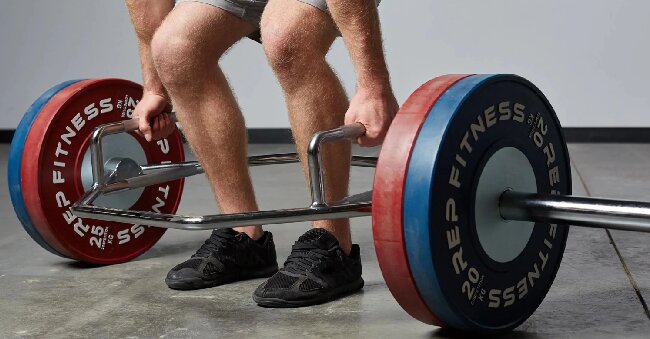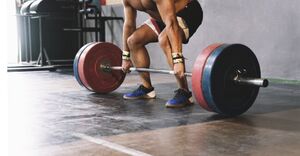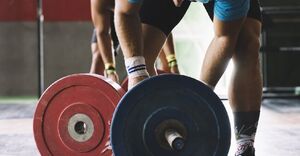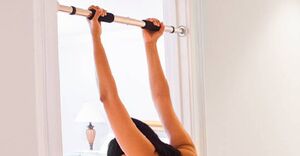
5 Essential Hex Barbell Exercises for Strength Training: Unlock Versatility in Your Workouts
If you’re looking to take your strength training to the next level, it’s time to consider the versatile hex barbell. While commonly associated with deadlifts, this unique barbell offers a wide range of exercises that target various muscle groups. From squats to overhead presses, the hex barbell can be a valuable tool in your fitness routine.
In this article, we will delve into the benefits of using a hex barbell, how to use it effectively, and the muscles it targets. Whether you’re a beginner or a seasoned lifter, there’s something for everyone with the hex barbell.
What Is a Hex Barbell?
A Hex Barbell, also known as a trap bar, is a specialized type of weightlifting equipment used in strength training exercises. It has a hexagonal or diamond-shaped frame with handles at the sides, allowing for a versatile range of movements and grips.
The design of the Hex Barbell enables users to perform exercises such as deadlifts, squats, and farmer’s walks with a more natural body positioning, reducing strain on the lower back compared to traditional barbells. This makes it an excellent choice for individuals looking to build strength and improve their overall fitness levels.
The unique shape of the Hex Barbell also allows for a neutral grip, targeting different muscle groups and offering variety in workout routines. Whether you’re a beginner or an experienced lifter, incorporating the Hex Barbell into your training regimen can enhance muscle development and prevent injury.
What Are the Benefits of Using a Hex Barbell?
Using a Hex Barbell offers numerous benefits, including increased versatility in exercises, targeted engagement of various muscle groups, and enhanced grip strength. The unique design of the hex bar allows for a more natural lifting position and reduces stress on the lower back.
This specialized barbell is especially effective for targeting major muscle groups like the quadriceps, hamstrings, glutes, and lower back. By incorporating compound movements such as deadlifts, squats, and lunges, the hex bar enables a more comprehensive workout that engages multiple muscle groups simultaneously.
The ergonomic design of the hex bar promotes proper form, which is crucial for injury prevention and maximizing performance gains. Its parallel handles offer different grip options, accommodating various hand positions to enhance stability and control during exercises.
How to Use a Hex Barbell?
Learning how to use a Hex Barbell effectively involves mastering proper form and technique in key exercises such as deadlifts, squats, farmer’s walks, and overhead presses. It is essential to start with lighter weights to focus on form and gradually progress to heavier loads.
- For deadlifts, ensure your feet are hip-width apart, grip the handles firmly, keep your back straight, and drive through your heels as you lift.
- When squatting, maintain a neutral spine, lower until your thighs are parallel to the ground, and push through your heels to stand up.
- Farmer’s walks engage your core and lower body – hold the bar and walk for a set distance.
- Overhead presses target the shoulders – stand tall, press the bar overhead in a controlled manner, and lower back down.
Deadlifts
Deadlifts with a Hex Barbell are a fundamental exercise for building lower body strength and engaging the posterior chain. Mastering the proper technique, including hip hinge and neutral spine alignment, is crucial to maximize muscle activation and prevent injuries.
By using a Hex Barbell, the grip positioning allows for a more neutral wrist angle, reducing strain on the forearms and enhancing overall stability. The hexagonal shape of the barbell centers the weight, promoting a more natural lifting motion.
Focusing on pushing through the heels and maintaining a tight core during the lift helps in activating the glutes, hamstrings, and lower back effectively. Engaging the posterior chain not only boosts strength but also aids in improving posture and reducing the risk of back injuries.
To enhance performance, gradually increase weights, incorporate proper warm-ups, and ensure adequate rest between sets.
Squats
Squats with a Hex Barbell are excellent for targeting the lower body muscles, including the quadriceps, hamstrings, and glutes. The hex bar design allows for more natural movement patterns and greater stability during the squatting motion.
This increased stability plays a crucial role in ensuring proper form and reducing the risk of injury while performing squats. By engaging multiple muscle groups simultaneously, such as the core, lower back, and stabilizing muscles, the hex bar squat promotes functional strength and enhances overall athletic performance.
The unique positioning of the hands at the sides rather than the front, as in traditional squats, can help individuals with shoulder mobility issues to execute the exercise with greater ease. Variations like sumo squats or elevated heel squats can further intensify the workout, targeting specific muscle areas for a well-rounded lower body regimen.
Farmer’s Walks
Farmer’s Walks with a Hex Barbell are an effective functional exercise that improves grip strength, overall stability, and enhances weight distribution. This exercise not only builds muscle but also promotes functional strength gains.
It is a compound movement that engages multiple muscle groups simultaneously, making it a time-efficient addition to any workout routine. The Hex Barbell design allows for a more neutral grip position, reducing strain on the wrists and shoulders. By regularly incorporating Farmer’s Walks with a Hex Barbell, individuals can experience enhanced core strength, improved posture, and increased muscular endurance. Variations such as increasing weight, altering distances, or incorporating turns can provide progressive challenges to continually stimulate muscle growth and development.
Overhead Press
The Overhead Press with a Hex Barbell is an effective compound exercise that targets the shoulders, triceps, and upper body musculature. Proper form and controlled movements are essential to enhance performance in this exercise.
Maintaining a stable core and bracing your abdominal muscles can help prevent excessive arching of the back during the Overhead Press with a Hex Barbell, reducing the risk of injury. By engaging the deltoids and triceps while pushing the barbell overhead, you can strengthen these muscle groups, leading to improved shoulder stability and overall upper body strength.
It is crucial to keep the elbows slightly in front of the bar at the starting position and press the bar directly overhead in a straight line. Remember to exhale during the upward phase and inhale as you lower the barbell back down to shoulder level to optimize your breathing pattern and maximize your performance.
What Makes Hex Barbell Different from Other Barbells?
The Hex Barbell offers unique advantages that set it apart from traditional barbells. Its hexagonal design allows for a more centered weight distribution, reducing stress on the lower back and promoting better lifting mechanics. When compared to standard barbells, the hex bar provides a more neutral grip position and engages muscle groups differently.
The hex bar’s design also enables a more natural lifting position, helping to decrease the risk of injury during lifts. Unlike standard barbells, the hex bar allows for a semi-enclosed space for the lifter, enhancing stability and reducing the risk of lateral movement. The hex bar’s dimensions often make it more accessible and user-friendly, accommodating a wider range of body types and abilities. This versatility makes the hex bar a popular choice for individuals looking to improve their strength training while minimizing strain on their lower back and joints.
What Muscles Does the Hex Barbell Target?
The Hex Barbell effectively targets multiple muscle groups, including the posterior chain (hamstrings, glutes, lower back), quadriceps, calves, traps, and forearms. Incorporating a Hex Barbell into weightlifting routines can lead to balanced muscle development and improved functional strength.
The activation of these specific muscle groups through Hex Barbell exercises plays a crucial role in enhancing overall strength and power. By engaging the posterior chain, individuals can improve their hip and knee extension capabilities, leading to better performance in various athletic movements. The quadriceps activation helps in strengthening the front of the thighs, essential for movements like squats and lunges. The engagement of the calves, traps, and forearms further contributes to a well-rounded development of muscle groups, promoting functional strength and stability.
Legs
The Hex Barbell is particularly effective for targeting the lower body muscles, including the quadriceps, hamstrings, glutes, and calves. Performing exercises like hex bar squats and lunges can significantly improve lower body muscle strength and power.
By incorporating these exercises into your training routine, you engage multiple muscle groups simultaneously, leading to enhanced muscle coordination and balance. The hex barbell’s design allows for a more natural and comfortable position during movements, reducing stress on the lower back and joints.
This not only helps in preventing injuries but also promotes proper form, maximizing the effectiveness of each repetition.
Consistent incorporation of hex bar exercises can aid in building functional strength, improving athletic performance, and supporting overall lower body development.
Back
The Hex Barbell row is an excellent exercise for targeting the back muscles, including the lats, rhomboids, and traps. This exercise promotes muscle endurance and strength gains in the upper back and can help improve overall posture and stability.
By incorporating Hex Barbell rows into your workout routine, you can effectively engage the entire back musculature, leading to a well-rounded and strong upper body. The rowing motion with the Hex Barbell helps in not only building strength but also in improving muscle endurance, allowing you to perform daily activities with more ease and efficiency. Focusing on these back muscles can aid in correcting imbalances, reducing the risk of injury, and enhancing your overall athletic performance.
Core
Engaging the core muscles is essential when using a Hex Barbell for exercises like farmer’s walks, lunges, and deadlifts. These movements challenge core stability and promote muscle activation throughout the abdominal region, contributing to overall strength and balance.
By maintaining a strong core during Hex Barbell exercises, you can significantly enhance your stability and increase the effectiveness of each repetition. Core engagement not only improves your ability to lift heavier weights safely but also reduces the risk of injury.
Incorporating specific core exercises like planks, Russian twists, and woodchoppers into your routine can further strengthen your core muscles, helping you maintain proper form and control during movements. These targeted exercises also aid in developing balance and coordination, crucial for maximizing the benefits of your Hex Barbell workout.
Can Beginners Use a Hex Barbell?
Beginners can certainly incorporate a Hex Barbell into their training program, as it offers a user-friendly design and reduces the learning curve associated with traditional barbell exercises. New lifters can start with lighter weights and focus on mastering basic movements before progressing to more advanced exercises.
This simplicity makes the Hex Barbell particularly suitable for those new to weightlifting. By beginning with manageable weights, individuals can develop proper form and technique while minimizing the risk of injury.
It is recommended for beginners to follow a structured training program that includes a mix of compound movements and isolation exercises to build overall strength and muscle. Over time, as confidence and proficiency grow, lifters can gradually increase the weight and intensity of their workouts for continued progress and development.
What Are Some Tips for Using a Hex Barbell Safely?
To use a Hex Barbell safely, it is crucial to prioritize proper form and technique in all exercises. Maintaining neutral spine alignment, engaging core muscles, and starting with manageable weights are key strategies to prevent injuries and ensure a safe training experience.
- When starting your workout, it’s essential to choose an appropriate weight that challenges you without compromising your form. Progress gradually by increasing weight incrementally as your strength improves.
- Remember to always brace your core during exercises to protect your lower back and maintain stability. Be mindful of common mistakes like rounding your back or shrugging your shoulders, as these can increase the risk of injury.
By focusing on core stability, using proper form, and gradually progressing, you’ll create a safe and effective training routine with the Hex Barbell.
Can Hex Barbell Be Used for Rehabilitation?
The Hex Barbell can be a valuable tool for rehabilitation purposes, particularly for individuals recovering from lower back, shoulder, or knee injuries. The design of the hex bar allows for modified movements and reduced stress on vulnerable joints, making it suitable for rehabilitating various musculoskeletal issues.
For those dealing with lower back injuries, exercises like hex bar deadlifts can help strengthen the posterior chain while minimizing strain on the lumbar region.
Similarly, individuals rehabbing shoulder injuries can benefit from modified hex bar overhead presses to improve shoulder stability without compromising on form.
Knee issues can also be addressed through exercises such as hex bar squats, which distribute the load evenly and reduce pressure on the knees, aiding in the recovery process.
The versatility of the hex barbell makes it a versatile and effective tool for targeted injury rehabilitation.
Lower Back Injuries
Individuals recovering from lower back injuries can benefit from exercises like Hex Bar Romanian Deadlifts, which emphasize hip hinge mechanics and promote muscle activation patterns without excessive lower back strain. These controlled movements aid in injury prevention and gradual strengthening of the posterior chain.
By focusing on the hip hinge mechanics, individuals engaging in Hex Bar Romanian Deadlifts can effectively activate the glutes, hamstrings, and lower back muscles in a balanced manner. This balanced muscle engagement not only helps in preventing further injury but also contributes to overall rehabilitation and recovery.
The emphasis on controlled movements during Hex Bar Romanian Deadlifts ensures that individuals with lower back issues can gradually strengthen their muscles without putting undue stress on the injury site, facilitating a safe and effective path to full recovery.
Shoulder Injuries
Individuals with shoulder injuries can utilize Hex Bar Shrugs to target the trapezius muscles and improve shoulder stability and muscle development. These exercises can aid in enhancing athletic performance by strengthening the upper back and promoting proper scapular movement.
By incorporating Hex Bar Shrugs into their rehabilitation programs, individuals can effectively engage the trapezius muscles, which play a crucial role in maintaining shoulder stability and supporting various shoulder movements. This targeted muscle development not only helps in recovering from injuries but also serves to enhance overall athletic performance by providing a solid foundation for better strength and endurance.
Promoting scapular movement through these exercises contributes to a more coordinated and efficient upper body function, which is essential for sports performance and everyday activities.
Knee Injuries
Individuals recovering from knee injuries can engage in Hex Bar Lunges to strengthen the lower body muscles, improve sports performance, and build overall leg strength. These controlled movements assist in rehabilitating knee issues while enhancing stability and functional strength.
By incorporating Hex Bar Lunges into their training regimen, those with knee injuries can experience significant benefits beyond just rehabilitation. The unique design of the hex bar allows for a more upright torso position, reducing strain on the lower back and emphasizing proper form. As individuals progress with this exercise, they not only strengthen their quadriceps, hamstrings, and glutes, but also enhance their explosive power and balance—essential components for athletes looking to optimize their performance on the field or court. The controlled nature of the lunging movements helps in developing proprioception, leading to improved coordination and agility.




No Comments